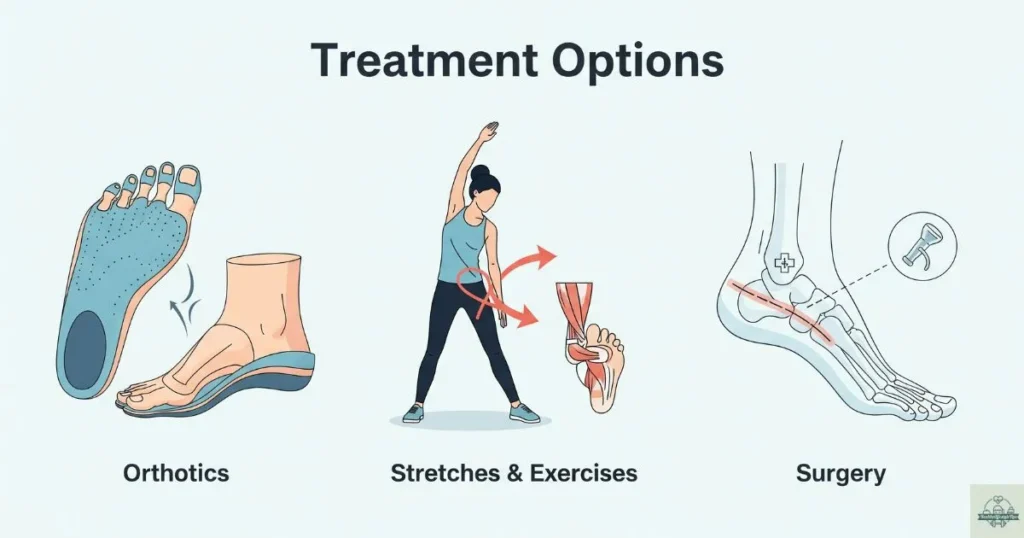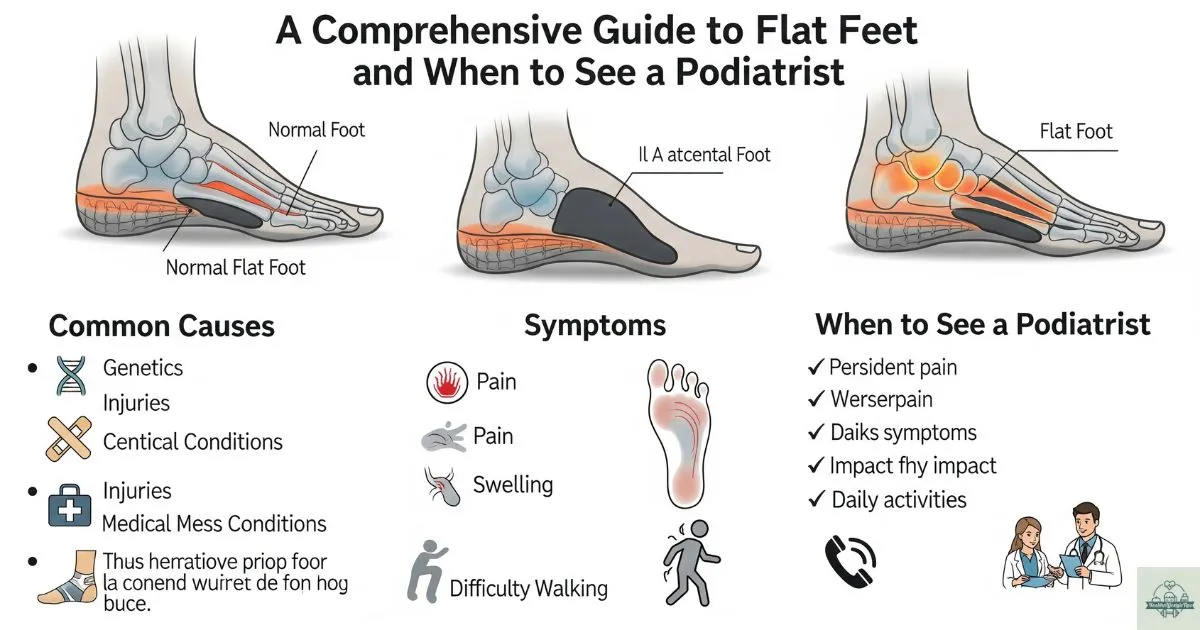Ever notice your whole foot leaving a print on the ground? That likely means you have flat feet—arches that don’t curve much. For many, this isn’t a problem, but sometimes, flat arches can lead to sore ankles, knees, or even your back.
Wondering whether to worry or rest? This guide makes it easy to understand flat feet, what causes them, and when to consult a podiatrist. Let’s find out how to keep your feet comfy and strong!
What Are Flat Feet and Why Do They Occur?

So, what exactly are flat feet? Think of them as feet that lack the usual inward curve, or arch, on the inside. This causes the entire bottom of your foot to press against the floor when you stand up. It’s super common, and often, it’s just the way you were born. Some people inherit them from their family, just like eye color.
Other times, arches can flatten out later in life. This can happen from an old injury, getting older, or even from wearing shoes that don’t give your feet enough support. It’s simply your body changing over time.
How Do Flat Feet Affect Your Body?
Think of your feet as the foundation of your body. When you have flat feet, that foundation can be a little wobbly. This might cause your ankles to roll inward when you walk or run. This change can create a chain reaction, traveling up your body. Soon, you might feel a little ache in your knees or find that your hips feel tired. It can even lead to a sore lower back because your body is working harder to maintain balance and alignment.
When Should You See a Podiatrist for Flat Feet?
So, when is it time to call in a pro? If your flat feet are causing pain that doesn’t go away, it’s a good sign to get them checked. You should also pay attention if your feet feel stiff, swollen, or weak. Trouble with balance or finding it hard to walk normally are other vital clues. And if only one of your feet has suddenly become flat, it’s definitely time to see a foot doctor, called a podiatrist.
Diagnosis of Flat Feet
So, what happens when you visit a podiatrist? First, they’ll want to look at your feet. They will watch you stand and walk to see how your feet move and where they make contact with the ground. This helps them understand your foot’s structure and alignment. To get a better look inside, they might also take special pictures, like an X-ray. This simple, painless process helps the doctor confirm if you have flat feet and figure out the best way to help you.
Treatment Options for Flat Feet

Once your doctor knows what’s going on, they can suggest ways to make your feet feel better. Often, simple things make a big difference. They recommend special shoe inserts called orthotics that give your arches a little lift and support. Stretches and exercises can also help strengthen your foot muscles. For more persistent pain from flat feet, surgery is an option, but it’s usually considered only after trying other, simpler treatments first. Your podiatrist will create a personalized plan for you.
Can Flat Feet Be Prevented or Corrected?
This is a great question that many people ask. While you can’t always prevent flat feet, especially if you’re born with them, you can take steps to avoid problems. Maintaining a healthy weight takes extra pressure off your arches. Wearing supportive shoes that fit well also gives your feet the foundation they need. Simple foot-strengthening exercises can help, too. While you might not be able to completely “reverse” your foot shape, these habits can make a huge difference in how your feet feel.
Also Read: Broken or Bruised Toe? How to Tell and What to Do Next
Flat Feet in Children vs. Adults
Did you know that almost all babies are born with flat feet? It’s totally normal! Their arches usually develop as they grow up and start walking. For most kids, this is just a temporary phase. But for adults, developing flat feet can be different. It might be due to wear and tear over the years or other health reasons. While it’s common for kids’ feet to be flat, if an adult’s arches fall, it’s more likely to need a check-up.
Flat Feet and Lifestyle
Having flat feet doesn’t mean you have to sit on the sidelines! You can still enjoy sports and fun activities. The key is to listen to your body and wear the right shoes. Choosing footwear with good arch support can make a world of difference when you’re running or playing. For everyday life, simple things like stretching your feet and avoiding standing for too long on hard surfaces can help keep you comfortable and active. It’s all about making minor adjustments for happy feet.
Read More: Comprehensive Guide to Ankle Rashes
FAQS
Can having flat feet stop me from playing sports?
Not at all! Having flat feet doesn’t mean you have to miss out on the fun. Choosing shoes with good support can help a lot, and sometimes special shoe inserts make playing even more comfortable.
Do flat feet always hurt?
Nope, many people have flat feet their whole lives and never feel any pain. Pain usually only happens if your feet get tired easily or if the way you walk puts stress on your knees or back.
Will my flat feet go away as I get older?
If you had flat feet as a kid, your arches might still develop as you grow. If you develop flat feet as an adult, they usually don’t go away on their own, but simple treatments can help them feel better.
What are the best shoes for flat feet?
The best shoes are ones that feel supportive and comfortable. Look for shoes that have good arch support and a sturdy heel to keep your foot stable and prevent it from rolling inward.
Do I need to see a doctor for my flat feet?
You only need to see a doctor if your feet are causing you pain, feel stiff, or make it hard to walk. A foot doctor, called a podiatrist, can figure out the best way to help you.
Conclusion
Understanding your feet is the first step to feeling great. While having flat feet is very common and often painless, you now know the signs to watch for. If you ever feel foot pain, stiffness, or have trouble walking, don’t just hope it goes away. Talking to a podiatrist can give you the correct answers and a plan to get you back on your feet comfortably. Paying attention to your body is a superpower, so listen to what your feet are telling you.
